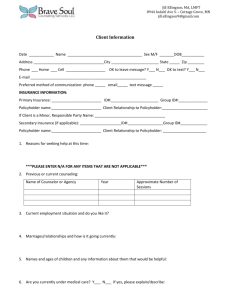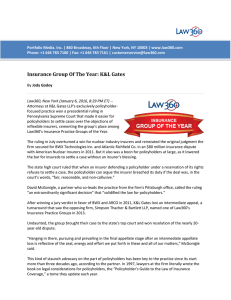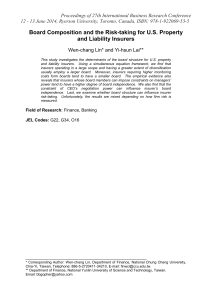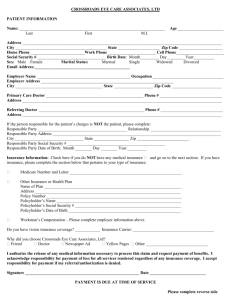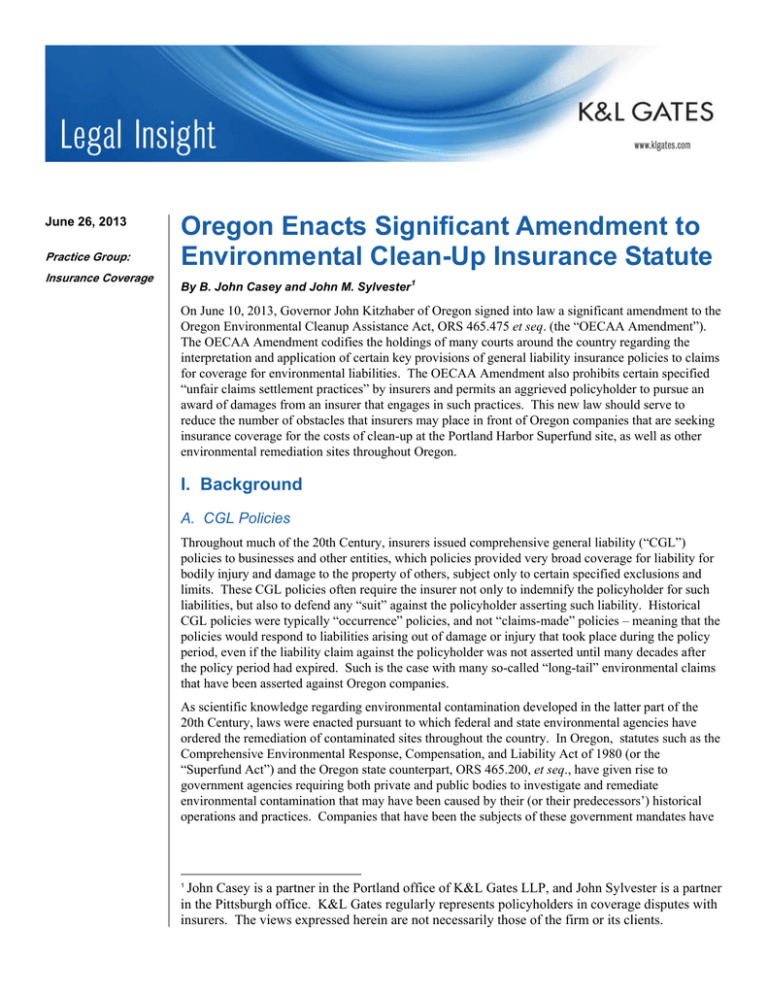
June 26, 2013
Practice Group:
Insurance Coverage
Oregon Enacts Significant Amendment to
Environmental Clean-Up Insurance Statute
By B. John Casey and John M. Sylvester 1
On June 10, 2013, Governor John Kitzhaber of Oregon signed into law a significant amendment to the
Oregon Environmental Cleanup Assistance Act, ORS 465.475 et seq. (the “OECAA Amendment”).
The OECAA Amendment codifies the holdings of many courts around the country regarding the
interpretation and application of certain key provisions of general liability insurance policies to claims
for coverage for environmental liabilities. The OECAA Amendment also prohibits certain specified
“unfair claims settlement practices” by insurers and permits an aggrieved policyholder to pursue an
award of damages from an insurer that engages in such practices. This new law should serve to
reduce the number of obstacles that insurers may place in front of Oregon companies that are seeking
insurance coverage for the costs of clean-up at the Portland Harbor Superfund site, as well as other
environmental remediation sites throughout Oregon.
I. Background
A. CGL Policies
Throughout much of the 20th Century, insurers issued comprehensive general liability (“CGL”)
policies to businesses and other entities, which policies provided very broad coverage for liability for
bodily injury and damage to the property of others, subject only to certain specified exclusions and
limits. These CGL policies often require the insurer not only to indemnify the policyholder for such
liabilities, but also to defend any “suit” against the policyholder asserting such liability. Historical
CGL policies were typically “occurrence” policies, and not “claims-made” policies – meaning that the
policies would respond to liabilities arising out of damage or injury that took place during the policy
period, even if the liability claim against the policyholder was not asserted until many decades after
the policy period had expired. Such is the case with many so-called “long-tail” environmental claims
that have been asserted against Oregon companies.
As scientific knowledge regarding environmental contamination developed in the latter part of the
20th Century, laws were enacted pursuant to which federal and state environmental agencies have
ordered the remediation of contaminated sites throughout the country. In Oregon, statutes such as the
Comprehensive Environmental Response, Compensation, and Liability Act of 1980 (or the
“Superfund Act”) and the Oregon state counterpart, ORS 465.200, et seq., have given rise to
government agencies requiring both private and public bodies to investigate and remediate
environmental contamination that may have been caused by their (or their predecessors’) historical
operations and practices. Companies that have been the subjects of these government mandates have
1
John Casey is a partner in the Portland office of K&L Gates LLP, and John Sylvester is a partner
in the Pittsburgh office. K&L Gates regularly represents policyholders in coverage disputes with
insurers. The views expressed herein are not necessarily those of the firm or its clients.
Oregon Enacts Significant Amendment to Environmental
Clean-Up Insurance Statute
turned to their historical CGL insurers for insurance coverage to assist in funding the costly clean-ups
that have been required. 2
In response to such requests for coverage, insurers frequently deny coverage on a variety of grounds,
including the following:
Missing Policies: In many cases, the environmental damage for which the policyholder is seeking
coverage commenced many decades ago. The policyholder may not have maintained copies of its
CGL policies from that time period. In those circumstances, and even when the policyholder may
have other kinds of historical business records and other evidence reflecting the missing policies,
an insurer that issued a policy may contend that it has no coverage obligation;
No “Suit”: Insurers often argued that a government-ordered environmental clean-up was not a
“suit” in the traditional sense of a lawsuit filed in court, and thus they had no duty to defend
policyholders faced with this type of governmental action; and
“Voluntary” Payments Not Covered: Insurers often have contended that payments made by a
policyholder in response to a consent order with a government agency were not covered
“liabilities” that were imposed upon the policyholder, but rather were “voluntary payments” – and
thus not intended to be covered by a liability policy.
As a result of these and other coverage defenses asserted by insurers, policyholders often have been
forced to initiate costly and time-consuming coverage litigation to enforce their contractual coverage
rights under their historical CGL policies. While such coverage litigation dragged on for years,
policyholders were incurring substantial – and possibly enterprise-threatening – costs to investigate
and remediate the environmental contamination at issue. Meanwhile, insurers had little incentive to
resolve their coverage disputes with policyholders in a timely fashion.
To address some of the difficulties in insurance recovery being experienced by Oregon policyholders,
the Oregon Legislature enacted the OECAA in 1999.
B. The OECAA
The Oregon Environmental Cleanup Assistance Act is a statute designed to clarify the interpretation
of certain insurance language upon which insurers have based some of their defenses to environmental
coverage claims. Notably, the OECAA is not limited to claims asserted by Oregon residents. Rather,
it applies to any policyholder that is a potentially responsible party for the clean-up of a contaminated
site located in Oregon. 3 The legislative purpose of the OECAA is stated as follows:
“465.478 Legislative findings. The Legislative Assembly finds that there are many
insurance coverage disputes involving insureds who face potential liability for their
ownership of or roles at polluted sites in this state. The State of Oregon has a substantial
public interest in promoting the fair and efficient resolution of environmental claims while
encouraging voluntary compliance and regulatory cooperation.” [1999 c. 783 § 3.]
2
In the mid-1980’s, general liability insurers began to incorporate the so-called “absolute
pollution exclusion” into their CGL policies, which purports to broadly exclude coverage for
liability for property damage arising from contamination or pollution.
3
ORS § 465.480(2)(a).
2
Oregon Enacts Significant Amendment to Environmental
Clean-Up Insurance Statute
To that end, the OECAA, among other things, provides as follows:
Insurers are required to cooperate with a policyholder to reconstruct missing policies. Specifically,
insurers are required to: (i) perform a search for lost policies within 30 days of receiving a notice
of lost policy from the policyholder, (ii) provide the non-privileged results of that search, and (iii)
if no policy is found, provide policy forms issued by the insurer during the applicable policy period
that are potentially applicable to the environmental claim. 4 Under the statute, the policyholder
must prove the issuance of the missing policy by a preponderance of the evidence. 5 Once the
policy is shown to have been issued, the burden is on the insurer to prove that any exclusion of
coverage for pollution or contamination was contained in the policy.
OECAA provides general rules of construction for certain ambiguous or undefined policy terms in
liability policies so long as the rules do not undermine the intent of the parties. For example:
o The statute interprets the term “suit” in the context of an environmental claim under a CGL
policy broadly to include instances when a governmental agency “directs, requests or agrees
that a policyholder take action with respect to contamination with the State of Oregon.” 6
o The statute provides that environmental investigation or remediation costs incurred by a
policyholder pursuant to a written voluntary agreement or consent decree with the DEQ or EPA
may not be denied by an insurer on the ground that such expense constitutes voluntary
payments by the policyholder. 7
o The statute also addresses an insurer’s duty to pay under a CGL policy that provides for “all
sums” coverage. Under these policies, the insurer is liable for all defense and indemnity costs,
up to a policy’s limit of liability, regardless of the existence of any other applicable insurance
that may provide coverage for the same claim. 8 This provision prevents an insurer from
avoiding a portion of its coverage obligations by arguing that the liabilities should be allocated
pro rata among all triggered policies.
II. The OECAA Amendment
Notwithstanding the positive impact of the original OECAA in clarifying the policy language upon
which insurers have based certain of their coverage defenses – including those policyholders that are
taking responsibility to clean up the Portland Harbor Superfund Site – a number of policyholders
continued to experience denials of coverage, significant delays and general frustration over insurers’
improper claims-handling practices. 9 The OECAA Amendment, introduced in the Oregon
Legislature as Senate Bill 814, was designed to address some of these issues. Importantly, the
OECAA Amendment is retroactive, “apply[ing] to all environmental claims, whether arising before,
on or after the effective date [of the] Act.” 10
4
ORS § 465.479(2)-(3).
ORS § 465.479(6).
6
ORS § 465.480(2)(b).
7
ORS § 465.480(2)(c).
8
ORS § 465.480(3).
9
See generally Testimony of Joan Snyder (“Snyder Testimony”) in Support of 2013 Senate Bill
814 at 1-2 (May 9, 2013).
10
ORS §465.480(8)(1).
5
3
Oregon Enacts Significant Amendment to Environmental
Clean-Up Insurance Statute
Like the OECAA, the OECAA Amendment provides rules of construction for certain ambiguous or
undefined policy terms and provisions in CGL policies that have been the basis for insurers seeking to
delay or deny coverage. Also like the original law, these new rules of construction are subject to a
“savings clause,” which provides that the interpretive rules “do not apply if the application of the rule
results in an interpretation contrary to the intent of the parties to the [insurance policy in question].” 11
Below is a summary of some of the principal features of the OECAA Amendment.
A. New Rules of Construction
1. Consent-to-Assignment Clauses
Many historical CGL policies contain a provision stating that a policyholder may not assign an
“interest in the policy” without the consent of the insurer. Insurers have argued that this provision
requires the policyholder to obtain consent for the assignment of claims for coverage that have already
accrued under the policy – as well as for assignment of rights to coverage under the policy for future
events. 12 This insurers’ argument was particularly troublesome for companies that had acquired or
merged with other companies whose historical operations were not considered environmentally
problematic during the period of those operations, but later were determined to have contaminated the
environment. Under the insurers’ interpretation of the consent-to-assignment clause, the surviving
company would not be able to access the predecessor company’s historical CGL policies because the
predecessor never had obtained the insurers’ consent to the assignment of its coverage claims to the
surviving company, even though the damage had already occurred – and therefore the right of the
predecessor to collect coverage under the policy had already accrued – prior to the assignment.
The case law in Oregon on the issue of assigning insurance policy rights was arguably somewhat
uncertain. 13 The OECAA Amendment clarifies this issue. Specifically, it provides that the standard
consent-to-assignment clause in CGL policies may not be construed to prevent the assignment of
environmental coverage claims under a policy after the damage has already taken place – and thus
after the claim against the insurer issuing the policy has already accrued. This provision of the
Amendment is in accord with the holdings of many courts around the country to the effect that
consent-to-assignment provisions were intended to prevent insurers from being involuntarily required
to insure a materially increased risk resulting from the assignment of a policy, but such provisions
were not intended to impede assignment of an already-accrued claim for coverage for a past incident
because such assignment did not materially increase the risk of the insurer.
11
See ORS § 465.480(7). Some opponents of the OECAA Amendment have argued that it is
unconstitutional because it purportedly impairs contracts. See, e.g., Testimony of Paul DeMuniz
on Senate Bill 814 (May 9, 2013). Proponents of the OECAA Amendment respond that it is
constitutional, in part because of this savings clause. See, e.g., Ex. F-2 (Memorandum from Joan
Snyder to Senator Betsy Johnson) to Snyder Testimony.
12
Snyder Testimony at 5.
13
Compare Holloway v. Republic Indem. Co. of America, 341 Or. 642, 652, 147 P.3d 329, 335
(2006) (anti-assignment clause in employer’s policy prevented assignment in settlement to former
employee/harassment victim), with Portland School District No. 1J v. Great American Insurance
Co., 241 Or. App. 161, 249 P.3d 148 (2011) (Oregon law allows assignment of liability insurance
claims where there is a liability judgment already entered against the policyholder).
4
Oregon Enacts Significant Amendment to Environmental
Clean-Up Insurance Statute
2. Non-Cumulation Provisions
Some liability policies contain a “prior insurance and non-cumulation of liability” provision, which
states that if any loss covered by the policy is also covered in whole or in part under any policy issued
for a prior period, the policy limits shall be reduced by any amounts due under such prior policies.
Policyholders have argued that this provision was drafted by insurers with the intention of preventing
a policyholder from obtaining a “double recovery” of insurance payments for the same loss – i.e.,
receiving coverage payments for the same liability from different insurance policies, for a total
recovery in excess of the amount of the loss. Notwithstanding that original intent, some insurers have
attempted to apply this provision to a long-tail environmental claim – where damage occurs over
multiple policy periods – in a manner that would reduce or eliminate the coverage available to a
policyholder from a subsequently issued policy by virtue of the issuance of an earlier policy that also
provides coverage for the environmental claim – even in a situation where the liability is so large that
the policyholder must collect coverage from both the earlier policy and the subsequent policy to be
fully reimbursed for that liability.
The OECAA Amendment makes clear that the non-cumulation provision may not be construed to
reduce the limits of coverage under a policy simply on grounds that a previously issued policy also
potentially provides coverage for the same environmental loss. Specifically, the Amendment provides
that the standard non-cumulation clause in CGL policies may not be interpreted to reduce the policy
limits for a policyholder that has filed a “long-tail environmental claim,” which is defined in the
statute as “an environmental claim covered by multiple general liability insurance policies.” By virtue
of this provision of the OECAA Amendment, insurers cannot continue in their attempts to interpret
and apply a non-cumulation provision in their policies as an “escape” clause, which voids their
coverage responsibility simply because an earlier-issued insurance policy also has coverage
obligations for the same environmental loss.
3. Owned Property Exclusion
CGL policies provide coverage for a policyholder’s liability for damage to another’s property, but
they do not typically cover damage to the policyholder’s own property. Thus, these policies often
contain “owned property” exclusions, which state that there is no coverage for losses to property
“owned” by the insured. In the context of environmental contamination claims, damaged property
often includes public waterways, the material below the water in these waterways (called
“sediments”), groundwater and soil. Oregon law is clear that public waterways, sediments beneath
such waterways and groundwater are owned by the public, and not by any particular policyholder. 14
Accordingly, the “owned property” exclusion should not apply to liability for costs associated with
damage to these types of third party property.
The issue of soil contamination on property owned by the policyholder, however, has been the subject
of some debate between policyholders and insurers. Policyholders typically argue that coverage for
the cost of remediating their own soil is not barred by the owned property exclusion if that
remediation is designed to prevent threatened – or to stop continuing – contamination to third party
14
See North Pacific Insurance Company v. United Chrome Prods., Inc., 122 Or. App. 77, 83, 857
P.2d 158, 161 (1993); Lane Electric Coop. v. Federated Rural Electric, 114 Or. App. 156, 161,
834 P.2d 502, 505 (1992), rev. den., 314 Or. 727, 843 P.2d 454 (Or. 1992); see also Or. Rev. Stat.
§§ 274.025, 537.110, 537.525(1).
5
Oregon Enacts Significant Amendment to Environmental
Clean-Up Insurance Statute
property. This argument is supported by case law in a number of jurisdictions. 15 Insurers, on the
other hand, argue that the cleanup of soil contamination on the policyholder’s property is not covered
under a general liability policy because the soil is “owned” by the policyholder – regardless of the fact
that the soil contamination may adversely affect property that is not owned by the policyholder.
The relevant case in Oregon on this issue is Schnitzer Investment Corp. v. Certain Underwriters at
Lloyd’s of London. 16 In Schnitzer, the Oregon Supreme Court held that the “owned property”
exclusion applied to bar coverage for the costs for soil remediation on a policyholder’s property
because there was no showing that the policyholder was simultaneously being required to remediate
damage to any groundwater or other non-owned property. 17 In so holding, the Court stated that, if
damage to third party property had not already occurred, a showing of threatened damage to such
property was insufficient to overcome the owned property exclusion hurdle. 18 Instead, actual damage
being caused to third party property was required to invoke liability coverage for a policyholder’s
cleanup of contaminated soil on property that it owned.
To address the foregoing dispute regarding the application of the “owned property” exclusion, the
OECAA Amendment clarifies that, if part of the remediation costs incurred by the policyholder
involves work that must be undertaken on the policyholder’s property to cut off the migration of
contaminants to non-owned property, the owned property exclusion may not be construed to preclude
coverage. Further, the policyholder need not show that actual damage to third party or public property
had already taken place. Rather, the Amendment makes clear that, if soil contamination on owned
property even “threatens to” damage third party property, coverage for the costs incurred to remediate
such soil in that context will not be barred by the owned property exclusion. In this way, the OECCA
Amendment overrides the part of the decision in Schnitzer providing that actual, rather than
threatened, damage to non-owned property must be taking place for the exclusion to be inapplicable.
4. “All Sums” Coverage Responsibility
The OECAA Amendment clarifies the OECAA’s “all sums” rule of construction. Specifically, the
statute provides that an insurer whose policy states that it has an obligation to pay “all sums” relating
to a liability claim may not refuse to make payment to a policyholder on the grounds that another
insurer also has coverage responsibility for that claim (the only exception to this rule is if the insurer’s
policy is an excess policy that expressly provides that the insurer has no obligation to respond to a
claim until the limits of the underlying policy have been paid). The OECAA Amendment provides
further guidance on how a policyholder may enforce its “all sums” coverage rights through litigation
in a situation where it sues less than all of the insurers that have overlapping coverage responsibility
for the same loss.
15
See, e.g., Intel Corp. v. Hartford Accident & Indem. Co., 952 F.2d 1551, 1565 (9th Cir. 1991)
(California); Norfolk Southern Corp. v. California Union Ins. Co., 859 So. 2d 167, 194-95 (La.
Ct. App. 2003); Quincy Mut. Fire Ins. Co. v. Borough of Bellmawr, 799 A.2d 499, 510 (N.J.
2002); Aetna Ins. Co. v. Aaron, 685 A.2d 858, 864 (Md. Ct. Spec. App. 1996); Olds-Olympic,
Inc. v. Commercial Union Ins. Co., 918 P.2d 923, 930-31 (Wash. 1996); Northern States Power
Co. v. Fidelity and Cas. Co. of New York, 504 N.W.2d 240, 246 (Minn. Ct. App. 1993); State v.
Signo Trading Int’l, Inc., 130 N.J. 51, 64, 612 A.2d 932, 939 (1992).
16
341 Or. 128, 137 P.3d 1282 (2006).
17
Id. at 136, 1287.
18
Id. at 136, 1286.
6
Oregon Enacts Significant Amendment to Environmental
Clean-Up Insurance Statute
B. Insurer vs. Insurer Contribution Claims
An issue that both policyholders and insurers had contended was impeding settlements of
environmental coverage claims was the threat of contribution claims asserted by non-settling insurers
against insurers that had entered into good-faith coverage settlements with the policyholder. To
address this issue, the OECAA Amendment provides that:
An insurer that has paid all or part of an environmental claim may seek contribution from another
insurer that: (i) is liable or potentially liable to the policyholder; and (ii) “has not entered into a
good-faith settlement agreement with the insured regarding the environmental claim.” Thus, the
Amendment prevents a non-settling insurer that must pay a judgment of coverage to a policyholder
from pursuing a contribution claim against a settling insurer if the settling insurer had entered into
a good-faith settlement with the policyholder.
There is a rebuttable presumption that binding settlement agreements between an insurer and a
policyholder are made in good faith, and a settlement agreement approved by a court of competent
jurisdiction after 30 days’ notice to the other insurers is deemed a good-faith settlement agreement
with respect to all such insurers to whom such notice was provided.
The contribution rights set forth in OECAA preempt all common-law contribution rights.
C. Unfair Claims Practices
The OECAA Amendment defines a number of insurer claims-handling practices as “unfair settlement
practices” that will subject insurers to liability. The new “unfair settlement practices” include the
following:
Failing to comply with the “missing policy” requirements of Section 465.479;
Failing to commence investigation of an environmental claim within 15 working days after receipt
of a notice;
Failing to make timely payments for defense or indemnity costs;
Denying a claim for an improper purpose, such as to harass or to cause unnecessary delay or to
needlessly increase the cost of litigation;
Requiring that the policyholder provide answers to repetitive questions and requests for
information concerning matters or issues unnecessary for resolution of the environmental claim;
and
Failing to participate in good faith in a nonbinding environmental claim mediation requested by a
policyholder concerning the existence, terms or conditions of a lost policy or regarding coverage
for an environmental claim.
Under the Amendment, a policyholder aggrieved by any of these practices may give notice to the
insurer and the Oregon Department of Consumer and Business Services of an intent to file a claim
against the insurer. If the insurer fails to resolve the complaint within 20 days, the policyholder may
file a claim against the insurer in a court of competent jurisdiction “to recover the actual damages
sustained, together with the costs of the action, including reasonable attorney fees and litigation
costs.” Additionally, in such an action, the court may, if it finds that the insurer acted
“unreasonably,” award up to three times the actual damages.
7
Oregon Enacts Significant Amendment to Environmental
Clean-Up Insurance Statute
D. Independent Counsel
Insurers accepting the defense of their policyholders often require the policyholder to retain counsel
from a pre-approved list of law firms and attorneys, while at the same time reserving the right to deny
coverage if the policyholder is found liable in the underlying proceeding. The OECAA Amendment
requires that, if the insurer accepts the defense of the claim under a reservation of rights in this
manner, or if the policyholder has potential liability for the environmental claim in excess of the limits
of the general liability policy, the insurer must provide experienced, “independent counsel” to defend
the policyholder, which shall represent only the policyholder and not the insurer. And, to the extent
they are needed, the same rule applies to environmental consultants.
Proponents of the OECAA Amendment argued that this provision is intended to address the problem
of insurance companies hiring “panel counsel” – which typically offer discounted billing rates to the
insurer based on receiving a large volume of work – “without sufficient experience to defend insureds
while at the same time reserving their right to deny coverage … if the inexperienced counsel or
consultants they have hired are unsuccessful in defending the case.” 19
III. Conclusion
The goal of the OECAA Amendment is to clarify the proper interpretation of policy language upon
which insurers have based certain of their defenses to coverage for environmental claims arising in
Oregon, and to encourage quicker and less expensive resolution of such claims. This Amendment
may provide relief for those companies involved in the clean-up efforts at the Portland Harbor
Superfund Site, and at sites elsewhere in Oregon, that have had to fight with their insurers to obtain
insurance coverage for the costs of these efforts.
Authors:
B. John Casey
john.casey@klgates.com
+1.503.226.5716
John M Sylvester
john.sylvester@klgates.com
+1.412.355.8617
Anchorage Austin Beijing Berlin Boston Brisbane Brussels Charleston Charlotte Chicago Dallas Doha Dubai Fort Worth Frankfurt
Harrisburg Hong Kong Houston London Los Angeles Melbourne Miami Milan Moscow Newark New York Orange County Palo Alto Paris
Perth Pittsburgh Portland Raleigh Research Triangle Park San Diego San Francisco São Paulo Seattle Seoul Shanghai Singapore Spokane
Sydney Taipei Tokyo Warsaw Washington, D.C. Wilmington
K&L Gates practices out of 48 fully integrated offices located in the United States, Asia, Australia, Europe, the
Middle East and South America and represents leading global corporations, growth and middle-market companies,
capital markets participants and entrepreneurs in every major industry group as well as public sector entities,
19
Snyder Testimony at 8.
8
Oregon Enacts Significant Amendment to Environmental
Clean-Up Insurance Statute
educational institutions, philanthropic organizations and individuals. For more information about K&L Gates or its
locations, practices and registrations, visit www.klgates.com.
This publication is for informational purposes and does not contain or convey legal advice. The information herein should not be used or relied upon in
regard to any particular facts or circumstances without first consulting a lawyer.
©2013 K&L Gates LLP. All Rights Reserved.
9

![[Date] [Policyholder Name] [Policyholder address] Re: [XYZ](http://s3.studylib.net/store/data/008312458_1-644e3a63f85b8da415bf082babcf4126-300x300.png)
